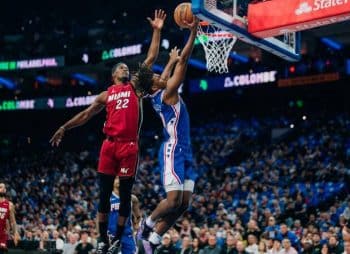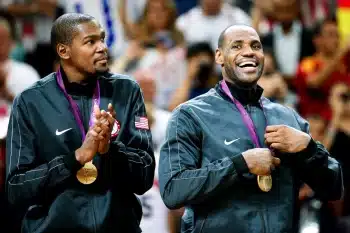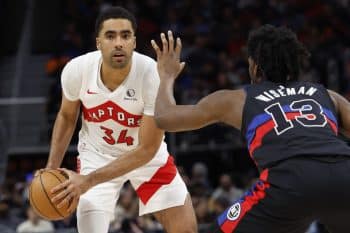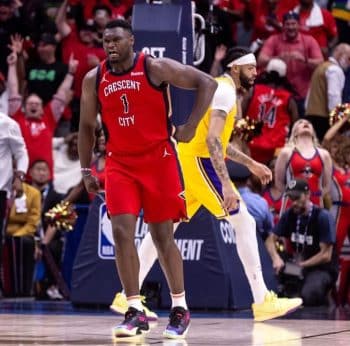NBA
NBA Daily: Chasson Randle Not Overlooking Shot With Thunder
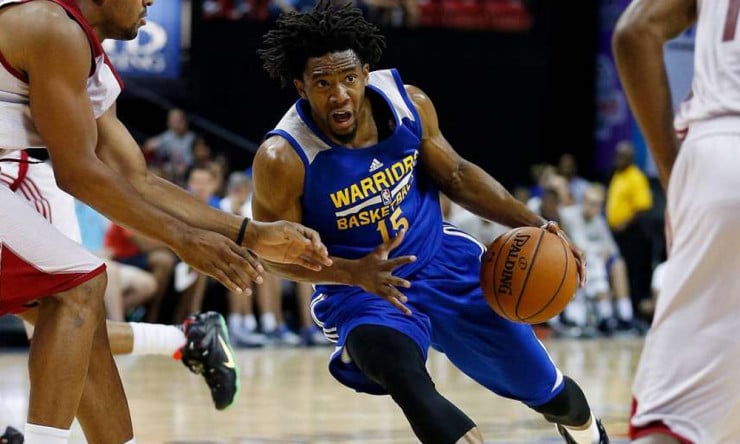
Shooting has always been valued in professional basketball, and it’s become even more important of late in the NBA. The league average for three-point attempts per game was 34.1 in 2019-20, up from 29 just two seasons earlier and 20 back in 2012-13, according to Basketball-Reference.
Well, that alone probably has a lot to do with why Chasson Randle is back in the NBA for the 2020-21 season.
“All summer long you hear teams are looking for shooting. That’s something I pride myself on – knocking down shots,” Randle recently told Basketball Insiders. “It’s something I work on constantly during the summer and the season, getting reps and staying confident.”
Randle is a career 37.8 percent three-point shooter with a career-high of 40 percent across 49 games with the Washington Wizards in 2018-19. But Randle is a pro’s pro, meaning he works on all aspects of his game and prides himself on more than just shooting.
“Picking up full [court], create a little havoc on the defensive end, changing the pace of the game,” Randle explained when asked about his other strengths. “And then I’ve worked on my playmaking ability and running the team all summer, making different reads out of pick and rolls and putting myself in situations that I’ll see in games.”
—
Randle has bounced around the NBA quite a bit for a 27 -year-old. In early December, he agreed to terms with the Oklahoma City Thunder for the 2020-21 season. Unfortunately, the team added a number of guaranteed contracts through trades this offseason and were unable to move players they may not be interested in keeping. As a result, Randle recently found out that he’ll start the 2020-21 season with the team’s G-League affiliate (the Oklahoma City Blue). Still, it is expected that he’ll be called up at some point this season.
Last season — just prior to the COVID-19 shutdown — Randle was with the Golden State Warriors, where he played three games. And while his time in California was cut short, he learned a lot from the organization.
“Everything is top-notch from top to bottom – how they communicate with each other [as an organization] and the players. And how the players communicate is huge,” Randle explained. “ [There’s] a lot of camaraderie and togetherness and it shows when they play. It was a short experience, I wish I would have had more time with them (to learn and compete), but I’m grateful for them none the less.”
The Warriors failed to qualify for the bubble, which prohibited Randle’s involvement in Orlando. But he explained that if given the opportunity to do so, he would have played any way he could.
“Yeah, absolutely,” Randle said. “I’m a basketball player. Anytime there’s a game going on, I’m down to play. I would’ve loved to have been in the bubble and showcase what I can do.”
But Randle has entirely new challenges ahead of him this season with the Thunder. Fortunately for the quasi-veteran, he’s not alone. Oklahoma City made a flurry of offseason moves that resulted in returning only six players from last season – Darius Bazley, Hamidou Diallo, Luguentz Dort, Shai Gilgeous-Alexander, Isaiah Roby and Mike Muscala. They’re a young team with limited continuity.
So, it would make sense that a player with Randle’s poise and professionalism could be able to carve out a role on such a young team.
“I think it’s a mix,” Randle said regarding his standing with the Thunder. “Thing about this game is that everybody has to be somewhat of a leader in their own way. I’ve been in roles where I’ve been the guy and I’ve also been in roles where I’ve had to follow. I’m comfortable doing both.”
“But this season in particular, whatever they need from me, I feel like I’ll be able to provide simply because over the course of my career, I’ve done so many different things, so I’m excited.”
According to his agent, Darrell Comer, Randle missed the 2020 preseason due to contract negotiations and the franchise’s need to make additional roster cuts. But Randle traveled with the team and observed them in action, so he’s encouraged with what he’s seen.
“Watching the guys throughout the preseason, I see a lot of things,” Randle said. “The ball moves. they’re playing free with a lot of pace and flow. I think my role fits right in as a shooter and a playmaker. And then on the defensive end, picking up full and being a pest.”
—
Randle repeatedly emphasized the idea of being more than a shooter over and over, often relaying his ability to make plays for others and defend. But he explained that the work he put since returning from a January stint in China has prepared him to prove it on the court. Randle followed a tedious training regimen in the Bay Area that began in April – and for much of the spring, he isolated himself from others outside his girlfriend by working out at home using whatever he could get his hands on.
“Early on. we didn’t know what the virus was,” Randle said. “I wasn’t going anywhere from when they shut things down in March until April. We stocked up. Luckily, my girlfriend can cook and I can do a little bit in the kitchen, too.
“But I was doing home workouts then, like on YouTube, and I had bands and free weights. Once mid-to-late April hit though, my girlfriend’s brother-in-law has a huge facility in his garage – machines, weights, treadmills, everything you need. I was there twice-a-day on most days. We called it the grindhouse, that was the deal. Then once I was able to get access to a court, probably a few weeks later, it was back to normal for me. Like an extended offseason.”
But once he was able to, he got right back to long days in the weight room, on the court and in film sessions, always trying to add just a little more to his game.
“Sunday is the Lord’s day, so I don’t do much on Sundays beyond stretching,” Randle explained. “Monday is weights at six in the morning until around ten. At ten, I get on the court shooting until noon. Then I’ll go back at like two-thirty or three and get another workout in with weights.”
But that wasn’t all.
“Also, if there’s a pickup game at night, I play pickup. And that’s like Monday-through-Friday. Saturday it was just one workout. I was lifting probably at least four times per week.”
But the best players are cerebral. They can’t just work on their craft, the most elite also prepare for their opponent, studying film, hoping to identify a weakness or a pattern to exploit.
“I’d also watch the film of myself, things I can improve on,” Randle continued. “My trainers do a great job sending me stuff through an app we have. I can watch my workouts to see how I’m shooting, my footwork.
“If it’s a pick-and-roll and the ball is in my hands. If it’s a live dribble. I’m looking get into the defender’s body, create contact, come off the screen . . . or if I’ve already used my dribble, setting up that man, making him think I could reject and then come off the screen.
“Or I’m looking at defense and my positioning, where I could have helped, my closeout. It’s all the little details you could pick up on that go a long way,” Randle said. “Everyone is so good in the NBA. It’s those details that separate the good from the really good players. So I’m just trying to figure out how I can get a little better every day.
“But another thing we focused on this offseason was my passing and making reads out of the pick-and-roll. I’ve been watching the film on Chris Paul and how he’s so patient coming off of screens, he uses his dribble to create windows for himself – and that’s stuff we work on in the gym. I’ll have a guy guard me, and a roller, and we’ll rep it out to build familiarity. Cutting down on turnovers, one-hand passes. Every little thing that can happen in a game. We had the time, we figured we might as well… for me, I’m always looking for ways to get better.
“Then I’m crashing at like ten-thirty to do it all again the next day. My girlfriend’s mad at me, but it’s the life, man. It’s something I’ve always wanted to do, being an NBA player.
“And I’m having so much fun enjoying the process.”
—
It’s somber times for many people in the United States and around the globe. COVID-19 has ravaged families, killing hundreds of thousands and leaving millions in financial peril. Its effect on athletes isn’t yet known, with long-term symptoms like brain fog not yet reported or discussed in professional athletes. Keyontae Johnson, a Florida University guard and 2019-20 All-SEC team member, recently collapsed during a game was recently diagnosed with acute myocarditis, which will force him to miss at least three months according to sources. So Randle is approaching COVID-19 with total seriousness, while not allowing it to get in the way of his dreams.
“I don’t believe they (NBA trainers and team executives) would put us in a situation where we would be harmed, or our families,” Randle explained. “I feel for that kid. I’m glad he’s doing great. At the end of the day, basketball is a way to provide for myself and my family. It’s something that’s been a part of me since I was a kid. To let that go in my prime, I wouldn’t be able to do that. I’m down to play now. I trust our medical staff and everyone has done a great job so far.”
But regardless of his determination, things will be different. To start the 2020-21 season, only six teams will allow fans to attend games, all of whom must obey local health mandates. A few others plan to open arenas up to fans at a later date. It won’t be exactly like the bubble, but it will be significantly different than the last time Randle was on an NBA court. Plus, for what it’s worth, most NBA arenas are significantly larger than the gyms in ESPN’s World Wide of Sports complex used for the bubble in Orlando, Florida, making it all the more daunting to play with a limited or non-existent crowd.
“I’ve talked to a lot of guys who played in the bubble and the pre-season with no fans – they say it’s weird,” Randle mused. “For me, you treat practice like a game and there’s no one in practice. So you go out there and do your job like it’s any other game. When I’m playing, I don’t necessarily see the fans, I hear them but don’t necessarily see them. They’re importing the 2K simulated sound in the arenas. But I’ll just have to see when we get there I guess.”
In the end, Randle belongs in the NBA – but lots of guys who aren’t there now can say the same thing. What’s slightly different about Randle is that he understands that. He’s grateful for the opportunity while also understanding that he needs to continue to prove himself.
But the professional in him expects to be criticized along the way, although Randle doesn’t necessarily buy into all of it.
“Criticism doesn’t hurt me,” Randle said. “If I don’t believe something somebody’s saying about me isn’t true, then I prove them wrong. It’s something I’ve had to do for a very long time. I can do it again. I’m all for learning and getting better.”
